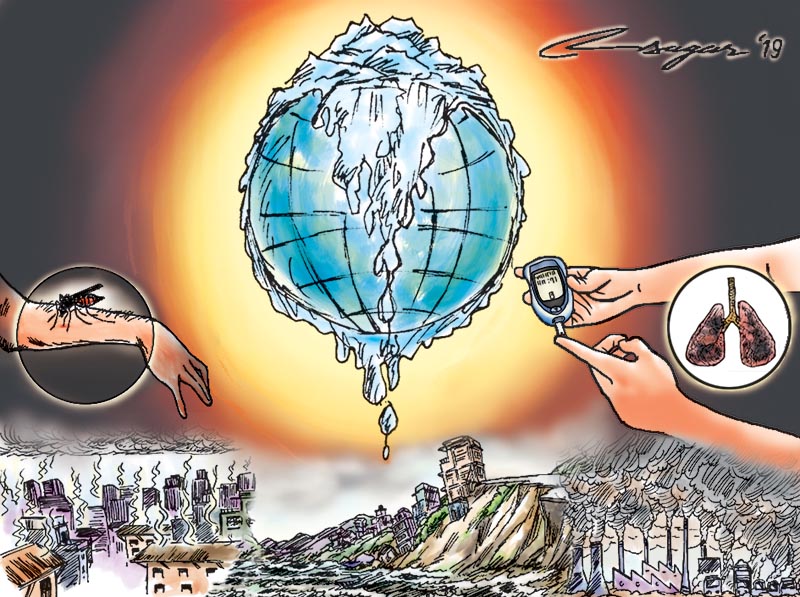Climate change: Its impact on health
Although climate change is a global issue, the degree of implications is location specific. So adaptation of the common remedies, as per the principle of sustainable development, to mitigate the health hazards is recommended
Recently, we saw snowfall and altered atmospheric conditions around the Kathmandu Valley. High density of snow invaded the upper hills, unseen before. Changes in the climate can affect not only the amount of snowfall but also influence the timing of the winter season. Spring has begun, the days are sunny, and the sky looks clear. But the rains during the summer are predicted to be erratic, although the amount of rainfall will not reduce. High rainfall intensity causes floods due to inundation of various low lands during the monsoon season. If the monsoon pattern alters due to climate change, much of the Ganges basin in Nepal and India will face violent consequences, based on the degree of climate change and what we have injected into our atmosphere.
The impact of climate change on health is vague and varied. Understanding the multidimensional relations requires rigorous and systematic effort while reaching a conclusion. There is also an endeavour to shed light on the major consequences based on scientific studies. Sunburn of our lungs happens when we inhale smog which causes chest pain, coughing and difficulties in breathing. It triggers asthma attack, exacerbating the conditions of bronchitis and emphysema. Extreme high temperature contributes directly to death from cardiovascular disease and respiratory disease.
The Anopheles mosquito spreads malaria while the Aedes species spreads dengue fever, yellow fever, elephantiasis, Zika and other diseases. Scientists have known for some time that climate change has caused the extension of the mosquito season beyond the summer months. Dengue epidemics have been on the rise in the past couple of decades. Mosquitoes increase to a point and then drop off. The most favourable period for spreading disease is when the temperature reaches 29 degrees Celsius. Increased temperature has brought about an expansion of the mosquito habitat. For instance, in the lower belt of Mustang, that is, the Trans Himalayan district, mosquitoes have migrated to the region, and people are compelled to protect themselves against them. Depletion of the ozone layer has a harmful effect on human health. This typically results from higher UV rays reaching us on earth. Research confirms that high levels of UV rays cause non-melanoma skin cancer. Additionally, it plays a major role in malignant melanoma development.
A WHO report states that floods contaminate freshwater supplies, heighten the risk of waterborne diseases, and create breeding grounds for disease-carrying insects, such as mosquitoes. A lack of safe drinking water can compromise hygiene and increase the risk of diarrhoeal disease, which kills more than 500,000 children below 5 years every year. Rising temperature and variable precipitation are likely to decrease the production of staple crops. The farmer will not be able to reap a good harvest and this will increase the prevalence of malnutrition in Nepal.
Recent research by Utah University revealed that reduced rainfall and high heat resulted in newborns who had low birth weight. Low birth weight already is a major global public health problem. Such infants face the potential of multiple health issues, including infections, respiratory distress, heart problems, jaundice, anaemia and chronic lung conditions. Later in life, they are at increased risk of developmental and learning disorders, such as hyperactivity and cognitive deficits.
Heated discussions are now being held around whether global warming can cause diabetes. Analysis by Dutch researchers in this regard has found that as the average annual temperature rose by 10C, the number of diabetic cases increased by 3.13 per 10,000 people. Not only that, they also concluded that each 10C increase in temperature was associated with 2.9 additional cases of obesity per 10,000 people. They have found that the warmer a place, the higher the rate of diabetes. The American Psychiatric Association recognises that climate change poses a threat to public health, including mental health. Those with mental health disorders are impacted by the consequences of climate change. Similarly, a study in Taiwan drew a sample of 100,000 people and proved that with every unit increase to particle pollution exposure, the risk of developing dementia grew by more 100 per cent.
Although climate change is a common global issue, the degree of implications is location specific. So the adaptation of the contextual and common remedies, embracing the principle of sustainable development proposed in agenda 21, to mitigate the health hazards is recommended.
Research done by the National Institutes of Health, USA shows that the ozone and fine particles may increase the risk of early pregnancy loss. Unfortunately, particulate matter in the air of the urban areas in Nepal is high. Even before a major industrial revolution in the country, it has already been facing harsh climate patterns. It is high time for the leadership to work on the Sustainable Development Goals and exhibit the will to play a responsible role as a watchdog of global events. Before it’s too late, the government wing must take climate leaders and environmentalists into the mainstream discussion of government initiatives.
Ghimire is a researcher, biomedical sciences, at Sunway University, Malaysia






